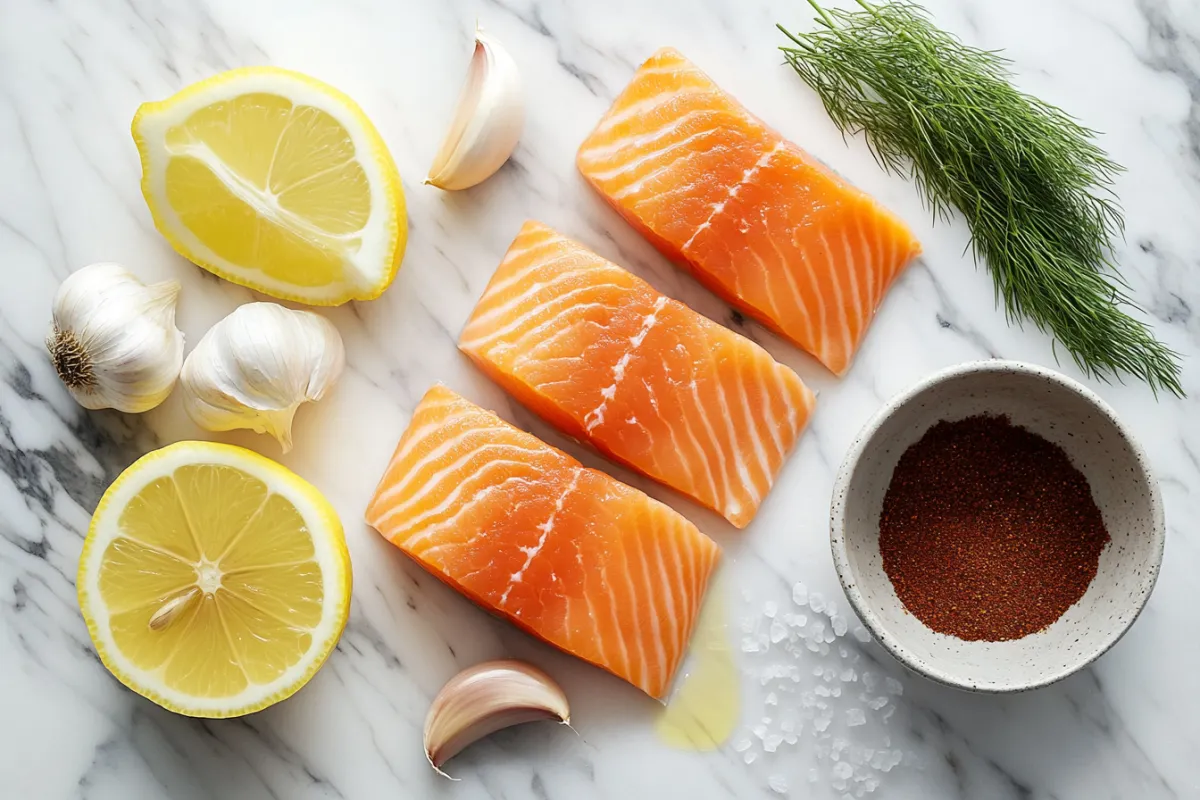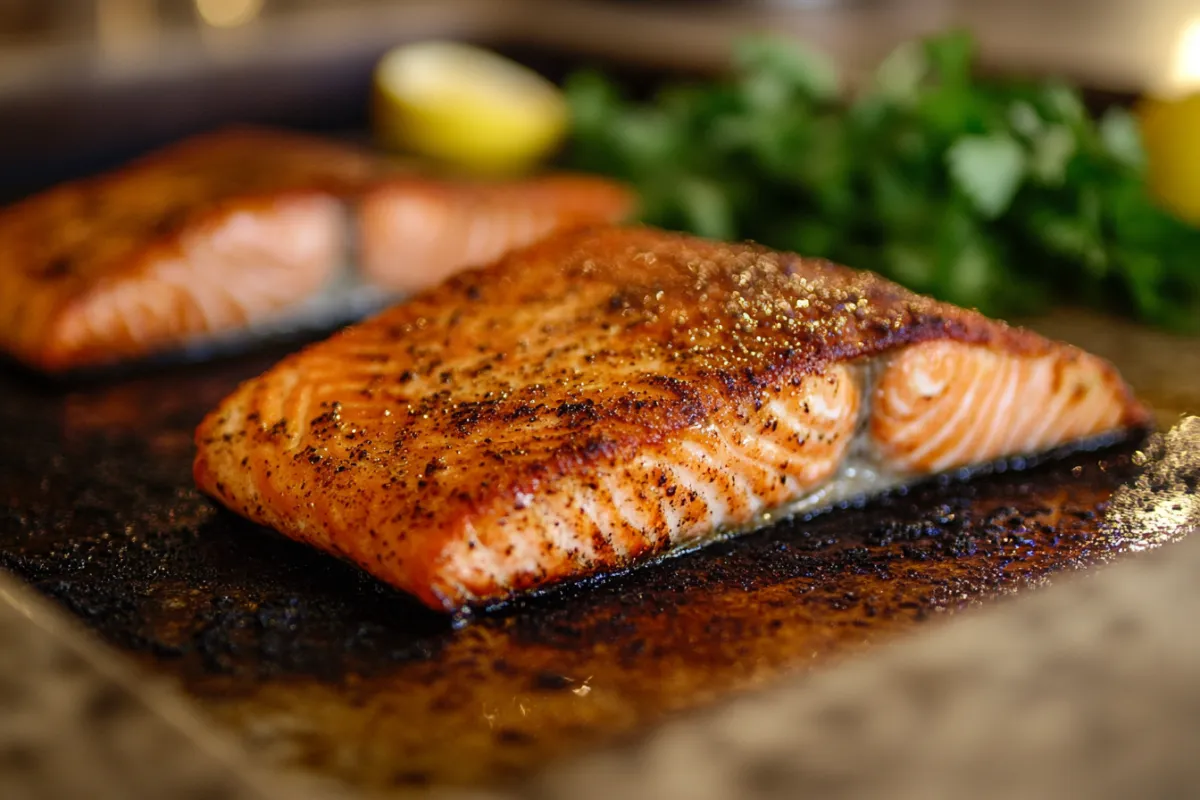Grilling salmon is an art that brings out the best in this flavorful fish, offering a smoky, slightly crispy texture that’s both delicious and versatile. Whether you’re cooking for a family dinner, a special gathering, or prepping meals for the week, grilled salmon never fails to impress. In this comprehensive guide, we’ll walk you through every detail of grilling salmon, from selecting the right fish to the best grilling techniques, seasoning tips, and serving suggestions. Let’s dive into how to grill salmon perfectly.
Why Grilled Salmon is a Popular Choice
Salmon is beloved for its rich, distinct flavor and health benefits, making it a favorite in kitchens around the world. Grilling enhances the fish’s natural flavors while giving it a beautiful charred crust that complements a variety of seasonings and marinades. This method is not only quick and easy but also a great way to enjoy a healthy, delicious meal with minimal fuss.
Health Benefits of Salmon
One of the key reasons salmon is so popular is its impressive nutritional profile. It’s an excellent source of high-quality protein and omega-3 fatty acids, which are essential for heart and brain health. Additionally, salmon is packed with vitamins B12 and D, as well as minerals like selenium and potassium, making it a nutrient-dense choice for any meal.
Versatility of Grilled Salmon
Another reason grilled salmon is a go-to dish is its versatility. It pairs well with an array of side dishes, such as roasted vegetables, salads, or grains like quinoa and rice. Grilled salmon can be served hot off the grill, chilled in salads, or even flaked into tacos and pasta dishes. The possibilities are endless, making it a versatile option for weeknight dinners or more elaborate occasions.
Choosing the Right Salmon
Before you can start grilling, you need to choose the right type of salmon. Selecting high-quality fish is crucial for achieving the best flavor and texture.
Wild-Caught vs. Farmed Salmon
When deciding between wild-caught and farmed salmon, there are a few things to consider. Wild-caught salmon, such as sockeye, coho, or king salmon, generally has a deeper flavor and a firmer texture due to its natural diet and lifestyle. However, it can be more expensive and less accessible. On the other hand, farmed salmon is typically more affordable and widely available but may have a milder taste and softer texture.
Fresh or Frozen
Fresh salmon is ideal for grilling, but frozen salmon can also be a good option if thawed properly. When buying fresh salmon, look for fillets with vibrant color, firm flesh, and a fresh sea-like smell. If you’re using frozen salmon, make sure to thaw it slowly in the refrigerator overnight for the best results.
Skin-On or Skinless
For grilling, skin-on fillets are recommended. The skin acts as a protective barrier, helping to prevent the fish from sticking to the grill while also adding a delightful crispy texture. If you prefer skinless salmon, be cautious, as it can be more prone to sticking and falling apart during cooking.
Preparing Salmon for the Grill
Once you have your salmon, the next step is preparing it for the grill. This involves seasoning the fish and deciding whether to use a marinade or a dry rub.

Marinade or Dry Rub?
Both marinades and dry rubs can add incredible flavor to grilled salmon. The choice depends on your time and flavor preferences.
- Marinade: Marinating salmon infuses it with flavor and helps keep it moist during grilling. A good marinade typically includes a combination of citrus juice (like lemon or lime), olive oil, garlic, herbs, and sometimes soy sauce for umami. Salmon should be marinated for at least 30 minutes but no longer than two hours, as the acid in the marinade can start to break down the fish, making it mushy.
- Dry Rub: If you’re short on time, a dry rub is an excellent alternative. Simply mix salt, pepper, smoked paprika, garlic powder, and any other favorite herbs and spices. The dry rub helps create a flavorful crust as the salmon grills, enhancing the natural taste of the fish without the need for a marinade.
Preparing the Grill
Properly preparing the grill is essential to avoid sticking and to ensure even cooking.
- Clean the Grates: Start by cleaning your grill grates thoroughly. Any leftover debris from previous grilling sessions can cause your salmon to stick.
- Oil the Grates: Once the grill is clean, lightly oil the grates with a high smoke point oil, such as vegetable or canola oil, to create a non-stick surface.
- Preheat the Grill: Preheat the grill to medium-high heat (around 375-450°F) before placing the salmon on the grates. This ensures the fish cooks evenly and develops that desirable grill char.
Step-by-Step Guide to Grilling Salmon
Grilling salmon to perfection requires attention to detail. Here’s a step-by-step guide to help you get it right every time.
1. Pat the Salmon Dry
Before grilling, pat your salmon fillets dry with a paper towel. Removing excess moisture ensures the salmon gets a nice sear and prevents it from steaming on the grill.
2. Season the Fillets
Season the salmon with olive oil, salt, and pepper. You can also add other seasonings like garlic powder, smoked paprika, or your favorite spice mix.
3. Grill Skin-Side Down
Place the salmon skin-side down on the grill. This method protects the flesh from the direct heat and ensures the skin becomes crispy. Grill for about 6-8 minutes, depending on the thickness of your fillet.
4. Flip Carefully
Once the salmon lifts easily from the grill, it’s time to flip it. Use a wide spatula to flip the fish gently to avoid breaking the fillet. Grill for another 2-5 minutes on the other side, until the salmon reaches an internal temperature of 130-135°F for medium doneness.
5. Let it Rest
After removing the salmon from the grill, let it rest for about 5 minutes. This allows the juices to redistribute throughout the fillet, making it more tender and flavorful.
Grilling Methods: Direct vs. Indirect Heat
The grilling method you choose can affect the outcome of your salmon. Both direct and indirect heat methods have their advantages.
Direct Heat
Direct heat is best for thinner fillets or when you want a crispier skin. Simply place the salmon directly over the heat source and grill for 6-8 minutes on each side. This method gives the salmon a charred exterior while keeping the inside moist.
Indirect Heat
Indirect heat is ideal for thicker fillets, as it cooks the fish more evenly without burning the exterior. To use this method, place the salmon on the cooler side of the grill, away from direct flames, and cook it more slowly. This results in a perfectly cooked, moist fillet.
Common Grilling Mistakes to Avoid
Grilling salmon may seem simple, but a few common mistakes can lead to less-than-perfect results. Here’s how to avoid them:
Overcooking
Salmon continues to cook even after it’s removed from the grill, so it’s important not to overcook it. Aim for an internal temperature of 130-135°F for medium doneness. The fish should be slightly opaque in the center and flake easily with a fork.
Skipping the Oil
Oiling the grill grates and the salmon itself helps prevent sticking. Without oil, the fish can easily tear when you try to flip it, ruining its presentation.
Flipping Too Early
Patience is key when grilling salmon. Wait until the fish releases easily from the grill before flipping it. Flipping too early can cause the salmon to break apart, especially if it’s not cooked enough on one side.
Flavor Enhancements for Grilled Salmon
Salmon is incredibly versatile when it comes to flavor, so don’t hesitate to get creative with your seasonings and marinades.
Popular Seasonings for Grilled Salmon
- Simple Seasoning: Olive oil, sea salt, and freshly ground black pepper bring out the natural flavors of the fish.
- Herb Blend: Fresh herbs like dill, parsley, and thyme give the salmon a bright, aromatic flavor.
- Citrus & Garlic: Lemon juice, lime zest, and garlic add a zesty, refreshing taste.
Marinade Ideas
- Lemon Herb: Combine lemon juice, olive oil, garlic, and fresh herbs like dill and parsley for a light, citrusy marinade.
- Soy Ginger: A blend of soy sauce, ginger, garlic, and honey offers a sweet and savory Asian-inspired flavor.
- Spicy Cajun: Mix paprika, cayenne pepper, garlic powder, and thyme for a bold, spicy rub that packs a punch.
Serving Ideas for Grilled Salmon
Grilled salmon can be paired with a variety of sides and sauces for a complete meal.

Ideal Sides for Grilled Salmon
- Grilled asparagus or zucchini
- Roasted sweet potatoes
- Quinoa or couscous salad with fresh herbs
- Garlic mashed potatoes
- A simple mixed green salad with a tangy vinaigrette
Creative Ways to Serve Grilled Salmon
- Salmon Bowls: Serve grilled salmon over a bed of rice or quinoa, topped with avocado, cucumber, and a sesame-soy dressing.
- Salmon Tacos: Flake the salmon and serve it in soft tortillas with slaw, avocado, and a drizzle of chipotle mayo.
- Salmon Salads: Add grilled salmon to a salad with mixed greens, tomatoes, cucumbers, and a lemon-tahini dressing.
Storing and Reheating Grilled Salmon
Grilled salmon is great for meal prep because it stores well and can be reheated without losing much flavor or texture.
Refrigeration
Store leftover salmon in an airtight container in the refrigerator for up to 2 days. Make sure the salmon is fully cooled before storing to prevent condensation, which can make the fish soggy.
Freezing
You can freeze grilled salmon for up to 3 months. Wrap each fillet tightly in plastic wrap, then place them in a freezer-safe bag. Label with the date to ensure freshness.
Reheating
The best way to reheat salmon is in a 275°F oven for about 10 minutes. Avoid using the microwave, as it can dry out the fish and result in an uneven texture.
FAQs About Grilling Salmon
How Do I Know When Grilled Salmon is Done?
The most accurate way to check if salmon is done is by using an instant-read thermometer. Aim for an internal temperature of 130-135°F for medium doneness. If you don’t have a thermometer, check if the fish flakes easily with a fork.
Should I Flip Salmon When Grilling?
Yes, but only flip the salmon once during grilling. Flipping too often can cause the fish to fall apart. Wait until the fish naturally releases from the grill before turning it.
Can I Grill Salmon Without the Skin?
You can grill salmon without the skin, but it requires a bit more care to prevent sticking. Make sure to oil both the salmon and the grill grates, and use a wide spatula to flip the fillets gently.
What’s the Best Way to Grill Salmon in Foil?
Grilling salmon in foil is a great way to avoid sticking and makes cleanup easier. To grill salmon in foil, place the fish in a foil packet with your preferred seasonings, seal it tightly, and grill for 10-12 minutes, or until the salmon is cooked through.
By following these tips, you’ll be able to grill salmon perfectly every time. Whether you’re grilling for a casual dinner or a special occasion, this method is sure to impress. For more delicious recipes, visit our homepage.

